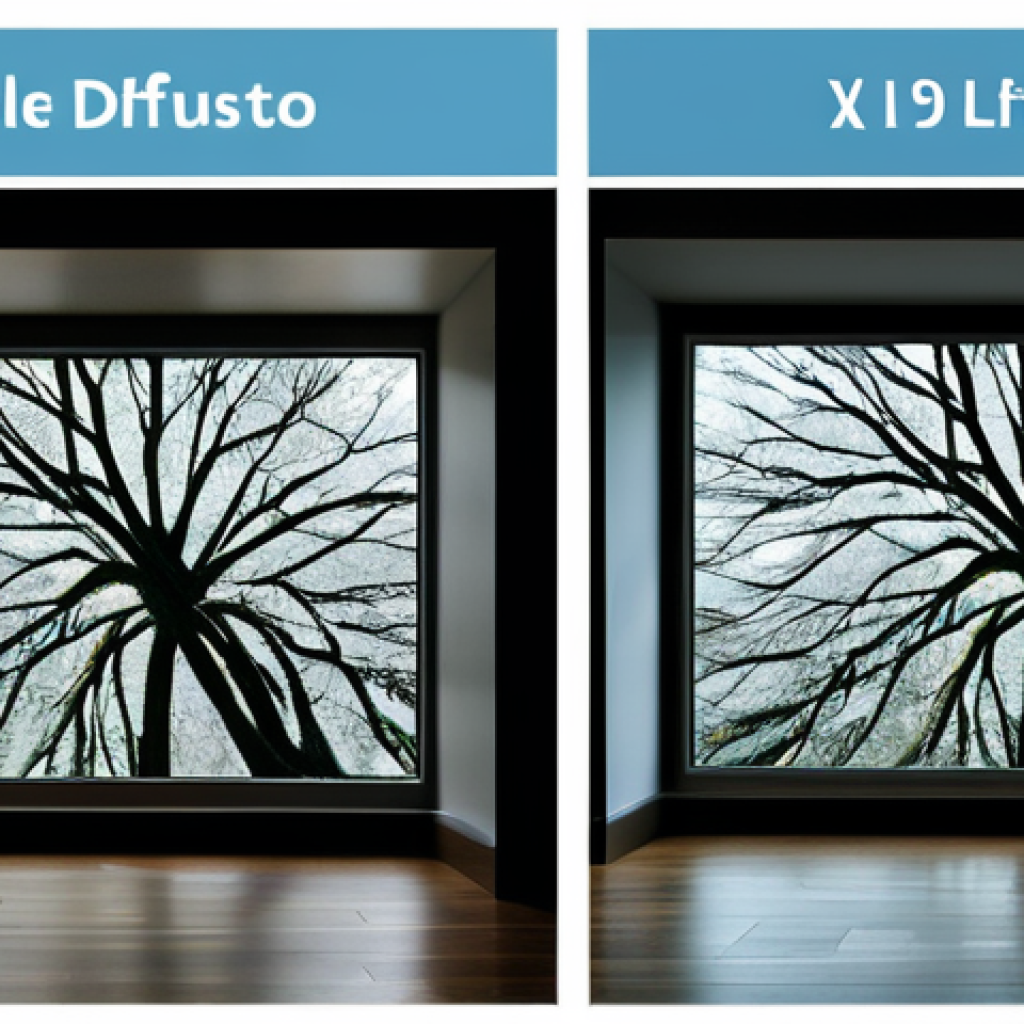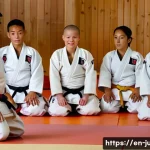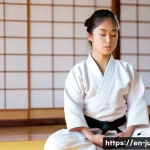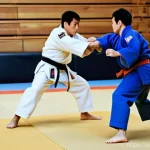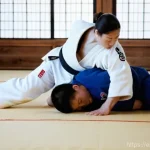Stepping onto the mat for the first time, I honestly didn’t know what to expect. My initial thought was, “Is this really going to be for me?” But what began as a hesitant curiosity quickly transformed into one of the most unexpected and rewarding journeys of self-discovery.
In an age where digital screens often dominate our lives and sedentary habits are becoming the norm, finding a physical outlet that truly engages both body and mind felt like striking gold.
I remember feeling that unique blend of nervous anticipation and sheer excitement, a rare sensation outside the virtual world. Beyond the throws and pins, what truly struck me was the incredible sense of community and the mental discipline Judo instilled.
It’s not just about physical prowess; it’s a powerful antidote to modern stress, a space for digital detox, and a practical application of mindfulness.
This holistic approach to well-being, blending ancient traditions with contemporary needs for mental resilience, is precisely why traditional martial arts like Judo are experiencing a resurgence.
My own experience highlights how these practices are becoming increasingly vital for navigating the complexities of our future, fostering not just physical strength but profound inner calm.
Let’s dive deeper in the article below.
The First Embrace of the Mat: More Than Just Physicality
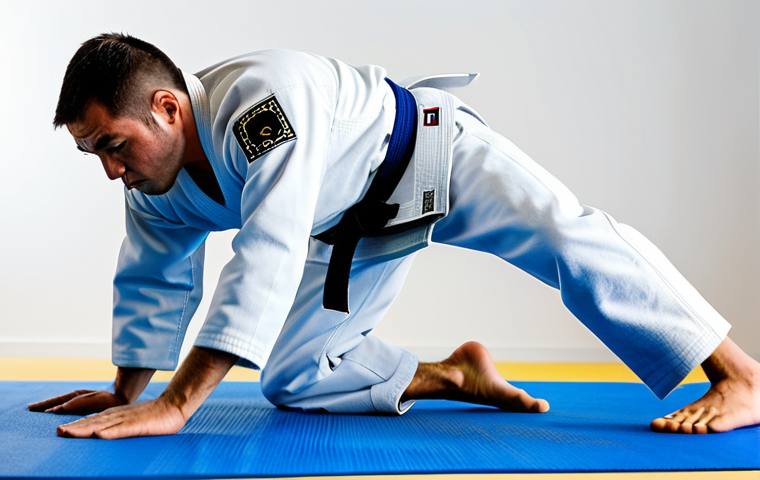
When I first stepped onto the crisp, clean surface of the judo mat, a ripple of quiet apprehension mixed with genuine curiosity ran through me. It wasn’t just a physical space; it felt like a boundary, a threshold into a world I knew little about.
I remember the subtle scent of the canvas, the slight give under my feet, and the hushed respect of the other practitioners already warming up. My muscles, accustomed to the soft comforts of a desk chair, immediately protested the sudden engagement.
My initial assumption, shaped by action movies and vague notions, was that judo was all about brute strength and spectacular throws. Oh, how delightfully wrong I was!
The early sessions shattered those misconceptions, revealing a profound dance of balance, leverage, and timing. It wasn’t about overpowering an opponent; it was about understanding their momentum, finding their weaknesses, and using their own energy against them.
This revelation was electrifying. It shifted my perspective from raw physical combat to a sophisticated, almost intellectual, challenge. The sheer amount of sweat pouring from me after those first few drills wasn’t just a testament to my lack of conditioning, but to the full-body engagement and the intense mental focus required.
Every fiber of my being was awake, alert, and learning. It felt like I was unlocking new physical capabilities I never knew I possessed, pushing my limits in ways that a treadmill or a gym session simply couldn’t replicate.
The sheer exhaustion was exhilarating, a deep-seated satisfaction that came from truly *using* my body, not just moving it.
1. The Unexpected Physical Demands
Before judo, my fitness routine was, to put it mildly, inconsistent. I’d dabble in cardio, lift a few weights, but nothing truly challenged my entire system in a coordinated, dynamic way.
Judo changed that almost immediately. I vividly recall the first time we practiced – repetitive entry drills for throws. My shoulders burned, my core screamed, and my legs felt like jelly.
It wasn’t just about the strength required for the throws; it was the explosive power, the constant shifting of weight, and the incredible demand on my cardiovascular system.
Every movement felt purposeful, from the subtle shift of a foot to the explosive turn of the hips. I discovered muscles I didn’t even know existed, and certainly hadn’t worked before.
The relentless grip fighting, known as , turned my forearms into rocks, a sensation I never thought I’d appreciate. What surprised me most was the incredible flexibility and mobility it demanded.
Despite popular perception, judo isn’t about being stiff; it’s about being fluid, adaptable, and responsive. My body, which often felt rigid after long hours at a desk, slowly began to loosen up, finding new ranges of motion.
This wasn’t just about gaining strength; it was about cultivating a holistic physical intelligence, teaching my body to move more efficiently and powerfully.
2. Discovering Hidden Strengths and Limitations
It’s easy to live life within the confines of our perceived capabilities. Judo, however, relentlessly pushes you beyond them. I quickly learned that what I thought were my strengths – a decent level of general fitness – were often offset by profound limitations in balance, coordination, and spatial awareness.
There were days when I felt utterly clumsy, tripping over my own feet, unable to execute a simple hip throw. The frustration was real, but so was the motivation to overcome it.
My instructors, with their calm patience, would meticulously break down each movement, helping me understand the intricate mechanics. It wasn’t about being naturally gifted; it was about consistent effort and a willingness to be a perpetual student.
I began to notice subtle improvements: a more stable stance, a quicker reaction time, a newfound ability to maintain my balance even when off-center. These small victories felt immense.
More importantly, I discovered an inner resilience. There were moments of doubt, moments when I felt like giving up, but the camaraderie and the sheer joy of learning pulled me through.
It was a profound lesson in humility and perseverance, teaching me that true strength isn’t just about what you can do, but about what you can endure and how you can adapt.
Beyond the Dojo Walls: Mental Fortitude and Discipline
The physical workout of judo is undeniable, but what truly resonated with me, and what I believe makes it so uniquely beneficial in our fast-paced modern world, is the profound mental transformation it instigates.
I entered the dojo often carrying the baggage of the day – work stress, digital distractions, an endless mental to-do list. Yet, the moment I stepped onto the mat, all of that faded away.
It had to. Judo demands your full, undivided attention. You cannot be thinking about your emails or your grocery list when someone is trying to throw you, or when you are trying to execute a complex technique yourself.
This forced presence, this total immersion in the moment, became a powerful form of mental discipline. It taught me how to quiet the incessant chatter of my mind, how to focus my energy, and how to maintain composure under pressure.
The mental demands are as rigorous, if not more so, than the physical ones. It’s a continuous problem-solving exercise, a chess match played with bodies, where every move and counter-move requires split-second decision-making and an unwavering commitment to the task at hand.
This level of sustained, high-stakes focus felt like a mental workout I’d never experienced before, sharpening my cognitive abilities in unexpected ways.
1. Cultivating Focus in a Distracted World
In an era saturated with notifications, endless feeds, and constant multi-tasking, true, deep focus feels like a lost art. Judo brings it back with a vengeance.
Each drill, each (free practice) session, demands an intensity of focus that is rarely replicated elsewhere. I remember sparring sessions where my mind would wander for even a fraction of a second, and in that instant, my opponent would capitalize, leaving me on my back.
It was a harsh but incredibly effective teacher. It taught me that presence is power. Slowly, almost imperceptibly, this laser-like focus began to extend beyond the dojo.
I found myself more present in conversations, more able to concentrate on complex work tasks, and less prone to succumbing to the siren call of my smartphone.
The ability to compartmentalize and dedicate full attention to one thing at a time, a skill honed on the mat, became an invaluable asset in my daily life.
It’s not just about concentration; it’s about learning to filter out noise, to prioritize, and to fully immerse yourself in the task at hand, whether that’s executing a perfect or analyzing a challenging report.
2. The Art of Patience and Persistence
Judo is not a sprint; it’s a marathon of incremental improvements. Some techniques took weeks, even months, to just begin to feel natural. There were countless repetitions, endless adjustments, and seemingly endless moments of frustration.
I’d watch more experienced practitioners execute techniques with effortless grace and wonder if I’d ever reach that level. But the dojo environment fosters a unique kind of patience.
You learn to trust the process, to celebrate small victories, and to understand that mastery comes from persistence, not instant gratification. This unwavering commitment to continuous improvement, even when progress feels painstakingly slow, taught me a profound lesson about life.
It reinforced the idea that truly valuable achievements are rarely instantaneous. They are the result of consistent, dedicated effort, of showing up even on days you don’t feel like it, and of embracing the long game.
This mental grit, this quiet resolve forged on the mat, has become a cornerstone of my approach to challenges far beyond the dojo, transforming how I tackle obstacles in my professional and personal life.
The Unspoken Language of Ukemi: Learning to Fall, Learning to Rise
One of the most foundational, yet often overlooked, aspects of judo is , the art of falling safely. When I first heard about it, I thought it seemed counter-intuitive.
Why spend so much time learning to fall? Wouldn’t I want to avoid falling entirely? But the wisdom of quickly became apparent.
In judo, you *will* be thrown. It’s an inevitable part of the learning process, and frankly, a crucial part of the sport. Without proper , every throw would be a potentially painful or even injurious experience.
Learning to fall correctly – to distribute the impact, to slap the mat to dissipate energy, to tuck your chin to protect your head – transformed falling from a fearful event into a controlled, manageable part of the practice.
It’s not just about avoiding injury; it’s about developing a profound sense of trust in your body and in the technique. This mastery over falling paradoxically empowers you to attempt more daring throws, knowing that if you misstep, you have the skills to land safely.
It’s an unspoken language of resilience, teaching you that setbacks are not failures, but simply moments to recover and try again. This profound lesson, born on the mat, has surprisingly far-reaching implications for how I navigate challenges in my everyday life.
1. Embracing Vulnerability and Resilience
Before , the idea of falling filled me with a primal fear. It felt like a loss of control, an embarrassing display of weakness. But in judo, falling is not only normalized; it’s a necessary step towards progress.
Every practitioner, from the novice to the black belt, practices . It’s a shared vulnerability that builds immense trust within the dojo. I learned to lean into that vulnerability, to accept that I would be thrown, that I would make mistakes, and that it was all part of the journey.
The incredible sense of relief that came from executing a good after a particularly strong throw was immense. It was a tangible demonstration of my growing resilience – the ability to absorb a shock, recover, and immediately get back up.
This wasn’t just physical resilience; it was deeply psychological. It taught me that failure isn’t the end; it’s merely a data point, an opportunity to learn and adjust.
This mindset has become invaluable in my life, transforming my approach to professional setbacks or personal disappointments. I’ve learned that truly resilient individuals aren’t those who never fall, but those who fall gracefully, learn quickly, and rise stronger each time.
2. Real-World Applications of Falling Safely
While is primarily taught for judo, its principles extend far beyond the dojo. How many times have we stumbled, slipped, or been caught off guard in everyday life?
My training has fundamentally changed how I react in such moments. I’m far more aware of my balance, my center of gravity, and how to distribute my weight.
I’ve caught myself countless times from what would have been embarrassing, or even injurious, falls – whether it’s slipping on ice, tripping over an unseen obstacle, or simply losing my footing.
The muscle memory from slapping the mat, tucking my chin, and rolling with the impact has become an automatic, life-saving reflex. It’s a testament to how deeply ingrained these physical lessons become.
Beyond the physical, the mental resilience forged through has proven equally valuable. When faced with unexpected challenges or “falls” in my career or personal life, I find myself less prone to panic.
Instead, I instinctively look for ways to absorb the impact, recover my balance, and strategize my next move, much like I would after being thrown on the mat.
It’s a powerful metaphor for navigating the unpredictable nature of life itself.
Finding Your Tribe: The Unexpected Community of Judo
Before joining judo, I considered myself a fairly independent person, content with my small circle of friends. I wasn’t actively seeking a new community, but the dojo unexpectedly offered one, and it quickly became one of the most enriching aspects of my entire experience.
From the very first session, there was an immediate sense of camaraderie. Everyone, regardless of rank or experience, was there to learn, to grow, and to help each other.
There was no pretense, no ego; just a shared passion for the art. I remember a sensei, a seasoned practitioner with decades of experience, patiently demonstrating a subtle grip adjustment to a complete beginner like me.
This willingness to share knowledge, to uplift others, and to genuinely care for each other’s progress was incredibly refreshing. Unlike many competitive environments, the dojo fostered a spirit of mutual respect and cooperation.
We pushed each other to improve, but always with an underlying current of support. This wasn’t just a group of people training together; it was a genuine – a united by shared challenges, triumphs, and countless hours on the mat.
This profound sense of belonging has, perhaps more than any physical skill, truly transformed my overall well-being.
1. The Bonds Forged Through Shared Effort
There’s something uniquely bonding about repeatedly throwing someone, and being thrown by them, all in a spirit of mutual learning and respect. It strips away pretenses.
When you’re both grappling, pushing your physical and mental limits, you quickly see each other for who you really are. I formed incredibly strong bonds with my training partners.
We celebrated each other’s breakthroughs, commiserated over frustrations, and offered quiet encouragement during tough sessions. There’s an unspoken understanding that develops when you’ve both pushed through exhaustion together, or when one of you helps the other perfect a challenging technique.
This shared struggle, the collective sweat and effort, creates a profound sense of solidarity that is hard to find in other areas of life. Beyond the mat, we’d share stories, offer advice, and sometimes even grab a coffee.
It wasn’t just about judo anymore; it was about genuine friendships built on a foundation of trust and shared experience. This tight-knit community became a powerful support system, reminding me that I was part of something bigger than myself.
2. Mentorship and Mutual Growth
The hierarchy in judo, while clear in terms of rank, is beautifully intertwined with a deep culture of mentorship. More experienced judoka, regardless of whether they were designated instructors, were always willing to offer advice, correct a subtle mistake, or simply share a word of encouragement.
I remember struggling with a particular (throwing technique), and an older, quieter practitioner patiently walked me through it, breaking down the footwork until it finally clicked.
There was no judgment, only a desire to help me improve. This spirit of giving back is fundamental to judo. As I progressed, I found myself instinctively doing the same for newer students, feeling a responsibility to pass on what I had learned.
This cycle of mentorship creates an environment of continuous mutual growth, where everyone is both a student and a teacher. It’s a powerful reminder that true expertise isn’t just about what you know, but about how you empower others to learn and grow alongside you.
The dojo became a micro-society built on respect, shared knowledge, and a collective pursuit of excellence.
Judo as a Digital Detox: Reconnecting with the Present
In a world constantly pulling us into digital realms, from endless social media scrolls to the relentless demands of email, finding a sanctuary that forces you to disconnect is vital.
For me, judo became that sanctuary, a literal and metaphorical mat where the digital noise of the outside world simply ceased to exist. The moment I stepped into the dojo, my phone was left in a locker, its presence irrelevant.
My mind, often racing with tabs open, instantly narrowed its focus to the immediate task: the feel of the , the balance of my partner, the mechanics of a throw.
There was no room for distractions, no space for the anxiety of unread messages or trending news. This forced digital detox wasn’t a chore; it was a profound relief.
It allowed me to fully inhabit my physical self, to reconnect with my body and my immediate environment in a way that modern life often doesn’t permit.
The intense physical and mental demands of judo acted as a powerful reset button, washing away the accumulated mental clutter of the day and grounding me firmly in the present moment.
It was a true escape, a place where mindfulness wasn’t just an abstract concept but a lived reality.
1. The Mat as a Sanctuary from Screens
Before judo, I would often unwind after a long day by scrolling through my phone or watching TV. It was a passive form of relaxation that often left me feeling more drained than refreshed.
The dojo offered a stark contrast. From the moment I bowed onto the mat, my focus was entirely on my body, my partner, and the instruction. There was no opportunity, nor any desire, to check my phone or get lost in a digital rabbit hole.
The physical exertion and the mental concentration required for each drill were so intense that my mind simply couldn’t wander to digital distractions.
It was liberating. It felt like my brain, constantly overstimulated by screens, was finally getting a much-needed break. The dojo became my designated “no-screen zone,” a place where genuine human interaction and physical engagement replaced the often-superficial connections of the online world.
It was a profound lesson in how much mental bandwidth we unknowingly surrender to our devices, and how rejuvenating it can be to reclaim that attention for ourselves.
2. Mindfulness in Motion: Present Moment Awareness
Many people turn to meditation for mindfulness, but for me, judo offers a unique form of “mindfulness in motion.” Every aspect of judo, from the subtle shifts in balance during (off-balancing) to the explosive execution of a throw, demands absolute present moment awareness.
If my mind wandered even for a second, I’d miss an opening or find myself off-balance. This constant need to be fully engaged in the here and now became a powerful form of active meditation.
My breath became deeper, my senses sharpened, and I felt more connected to my body than ever before. This wasn’t about clearing my mind of thoughts; it was about focusing my thoughts so intently on the physical task that there was no room for anything else.
This sustained state of presence, born on the mat, slowly began to permeate other areas of my life. I found myself eating more mindfully, listening more intently in conversations, and generally experiencing life with a heightened sense of awareness.
It wasn’t just a physical workout; it was a powerful training ground for cultivating a deeper, richer connection to the present moment, transforming how I experienced everyday life.
Navigating Life’s Throws: Practical Applications of Judo Principles
One of the most profound aspects of my judo journey has been realizing how directly its principles apply to the challenges of everyday life. It’s not just a sport; it’s a philosophy, a framework for navigating conflict, stress, and unexpected changes.
I remember one particular session where my sensei explained (off-balancing) not just as a physical technique, but as a concept for finding an opponent’s weak point, creating an opportunity.
It immediately clicked for me: this wasn’t just about throwing a person; it was about identifying vulnerabilities, shifting perspectives, and creating leverage in any situation.
Life, much like a judo match, is full of moments where we feel off-balance, where unforeseen circumstances “throw” us. Judo provides a mental toolkit for how to react in these moments: how to absorb the impact (ukemi), how to find your footing again, and critically, how to turn an apparent disadvantage into an opportunity.
This wasn’t abstract theory; it was practical, embodied wisdom that taught me to approach problems with a more strategic, adaptable, and ultimately, more resilient mindset.
The dojo became a microcosm of life, a safe space to practice responses to various pressures.
1. Applying Kuzushi to Everyday Challenges
The principle of in judo, the art of breaking an opponent’s balance, has been surprisingly useful in my professional life. I used to approach problems head-on, sometimes feeling like I was just ramming into a brick wall.
But judo taught me that direct force isn’t always the answer. Instead, it’s about understanding the opposing force, identifying its center of gravity, and applying subtle pressure to shift its balance, creating an opening.
In team meetings, when faced with a rigid viewpoint, I’ve found myself instinctively looking for the “kuzushi” – not to aggressively overpower, but to gently shift perspectives, to ask questions that subtly reveal weaknesses in an argument, or to propose alternatives that destabilize the status quo without causing outright confrontation.
It’s about finding that small moment of imbalance where a solution can be introduced more effectively. This strategic approach has made me a more effective problem-solver and negotiator, allowing me to navigate complex situations with greater finesse and less friction.
It’s amazing how a martial art can teach you to be a more effective communicator and leader.
2. The Philosophy of Adaptation and Flow
Judo is a constant dance of adaptation. No two partners are the same, no two situations identical. You must constantly adjust your grip, your footwork, your strategy based on the immediate feedback from your opponent.
Trying to force a technique when the conditions aren’t right is often futile and exhausting. This dynamic interplay taught me the profound value of adaptability and flow.
In my personal life, when plans go awry or unexpected obstacles emerge, I now find myself less rigid, less resistant to change. Instead, I try to emulate the fluid responsiveness of a judoka, assessing the new landscape and adapting my approach.
This philosophy of “go with the flow, but direct it” has significantly reduced my stress levels and made me more resilient in the face of uncertainty.
It’s about being present enough to read the situation, flexible enough to change your trajectory, and confident enough to trust your ability to improvise.
It’s a powerful antidote to the anxiety of an unpredictable world, fostering a deep sense of inner calm even amidst external chaos. Here is a table summarizing some of the unexpected benefits of Judo from my perspective:
| Benefit Category | Initial Expectation | Actual Impact (My Experience) |
|---|---|---|
| Physical Health | Basic cardio & strength | Holistic full-body conditioning, improved flexibility, injury prevention via Ukemi, functional strength, explosive power. |
| Mental Well-being | Stress relief (from exercise) | Profound digital detox, enhanced focus & concentration, emotional regulation under pressure, reduced anxiety, heightened present moment awareness. |
| Personal Development | Learning self-defense techniques | Cultivating patience, perseverance, humility, resilience in failure, strategic problem-solving (Kuzushi), adaptability, and confidence. |
| Social Connection | Individual sport activity | Strong community bonds, genuine friendships, mentorship opportunities, shared purpose, trust through vulnerability, sense of belonging. |
Sustaining the Journey: Integrating Judo into a Modern Lifestyle
Embarking on a new passion is one thing; consistently integrating it into an already packed modern life is quite another. I won’t pretend it’s always been easy.
There are days when work demands are high, when I feel utterly exhausted, or when social commitments beckon. Yet, the profound benefits I’ve reaped from judo have made it non-negotiable.
It’s no longer just an activity; it’s a vital pillar of my well-being. I’ve learned that consistency, even when it means showing up for a shorter session or a less intense practice, is far more important than sporadic bursts of heroic effort.
It’s about finding that sweet spot where training enhances, rather than detracts from, other areas of my life. This means planning my week meticulously, sometimes even saying no to other engagements, because I’ve come to understand that my time on the mat isn’t just about physical exercise; it’s about mental clarity, emotional release, and a deep connection to something meaningful.
It’s an investment in my overall resilience and happiness. The long-term impact of judo extends far beyond the physical transformation, profoundly shaping my approach to health, self-care, and continuous personal evolution in a world that never stops moving.
1. Balancing Training with Daily Commitments
One of my biggest concerns initially was how I would fit judo into my already busy schedule. Like many, I juggle a demanding job, family responsibilities, and other personal interests.
The key, I’ve found, is to treat judo sessions not as optional activities, but as essential appointments for my well-being. Just as I wouldn’t skip a crucial work meeting, I try not to skip my training.
This often requires careful planning, sometimes adjusting my work hours slightly, or being more efficient with my time during the day. There have been periods where I’ve had to scale back, perhaps attending only once a week instead of two or three, but the goal has always been to maintain consistency.
I’ve learned to listen to my body, understanding that some days call for a less intense practice, focusing more on technique than on hard sparring. The dojo community is incredibly understanding and supportive of these real-life challenges, further reinforcing that it’s about the long game, not just immediate performance.
This flexibility has allowed me to sustain my judo journey without feeling overwhelmed, turning it into a harmonious part of my daily rhythm.
2. Long-Term Well-being and Personal Evolution
Judo isn’t just about becoming strong or skilled; it’s about continuous personal evolution. Looking back at my hesitant first steps onto the mat, I’m struck by how much I’ve grown, not just physically, but mentally and emotionally.
The discipline, the resilience, the humility, and the sense of community I’ve gained are now deeply ingrained parts of who I am. It’s a journey without an endpoint, a perpetual learning process that keeps me engaged and challenged.
My physical health has never been better, my stress levels are significantly lower, and I approach life’s challenges with a newfound calm and strategic mindset.
Judo has become a fundamental anchor in my life, providing a consistent space for self-improvement and genuine connection. It’s a powerful reminder that investing in experiences that challenge and nurture both body and mind leads to a profoundly richer and more fulfilling life.
The lessons learned on the mat continue to unfold in unexpected ways, proving that the ancient art of judo remains remarkably relevant and transformative in our modern world.
Closing Thoughts
My journey on the judo mat has been nothing short of transformative. What started as a simple curiosity to try a new physical activity has blossomed into a profound passion, reshaping not just my body, but my mind and spirit.
Judo has become a fundamental pillar of my well-being, a powerful anchor in a chaotic world, consistently reminding me of the strength that lies within resilience, the beauty in discipline, and the profound value of genuine human connection.
If you’re looking for more than just a workout, but a path to holistic growth, step onto the mat. It might just change your life, too.
Useful Information
1. Finding the Right Dojo: When searching for a judo club, prioritize a welcoming atmosphere and experienced, certified instructors. Many dojos offer a free trial class, which is an excellent way to experience the environment and teaching style firsthand before committing.
2. What to Expect as a Beginner: Your first few sessions will heavily focus on (breakfalls) – and rightly so! This foundational skill is crucial for safety and confidence. Embrace the learning process, be patient with yourself, and don’t be afraid to ask questions.
3. Essential Gear: All you truly need to start is comfortable workout attire. Most dojos will lend you a (judo uniform) for your initial classes. If you decide to continue, investing in your own and a water bottle for hydration will be your main purchases.
4. Judo is for Everyone: Regardless of age, gender, or current fitness level, judo offers benefits. It’s not about brute strength but technique and leverage. Many dojos have classes tailored for different age groups and skill levels, making it accessible to a wide range of individuals.
5. Beyond the Physical: While the physical workout is intense and rewarding, be prepared for significant mental and emotional growth. Judo cultivates discipline, focus, humility, and problem-solving skills that extend far beyond the dojo walls, enriching every aspect of your life.
Key Takeaways
Judo is a holistic practice that offers far more than physical fitness. It profoundly enhances mental fortitude through discipline and focus, fosters resilience by teaching the art of falling and rising, and builds strong community bonds based on shared effort and mutual respect.
Its principles, such as adaptation and off-balancing (), provide practical life skills for navigating challenges, serving as a powerful digital detox and a pathway to sustained personal evolution in a modern world.
Frequently Asked Questions (FAQ) 📖
Q: In an era dominated by screens and sedentary lifestyles, how does Judo, a traditional martial art, uniquely stand out as a solution for modern challenges?
A: Honestly, when I first started, I thought it might just be another workout, a way to move a bit more and maybe learn a cool self-defense move. But it’s so much more.
What struck me, truly, was how Judo forces you to be present. We’re all glued to screens, right? Constantly scrolling, multitasking, feeling that low hum of digital noise.
Stepping onto the mat is like hitting a hard reset. You can’t be distracted; your mind has to be focused on your opponent, your balance, the next move.
It’s a powerful, non-negotiable digital detox. I’ve found that the sheer mental engagement – the problem-solving in real-time under pressure – offers a kind of mindful application that just melts away the everyday stress.
It’s not just an escape; it’s a recalibration, teaching you to channel that scattered modern energy into something incredibly focused and grounding.
Q: You mentioned an “incredible sense of community” in Judo. What makes this community aspect so special or different from other group activities?
A: Ah, the community – that’s probably the most unexpected gift of Judo. You walk in, a bit nervous, and you’re immediately part of this shared journey. It’s not like a gym where everyone’s doing their own thing with headphones on.
Here, you’re literally grappling with people, learning to fall safely with them, trusting them, pushing each other. There’s a raw vulnerability in that, and it builds an unspoken bond.
I’ve been in groups where you just show up, do your thing, and leave. But in Judo, there’s a genuine camaraderie, a mutual respect that comes from sweating together, getting thrown, and then helping each other up.
It’s a place where you’re seen, your progress is cheered, and setbacks are met with encouragement, not judgment. It feels like a real tribe, an anchor in a pretty disconnected world.
Q: How exactly does Judo cultivate “profound inner calm” and “mental resilience” when it seems so physically demanding?
A: It might seem counter-intuitive, right? All that pushing and pulling, the physical exertion. But that’s precisely where the magic happens.
“Inner calm” isn’t about being passive; it’s about being able to manage chaos, both externally and internally. On the mat, you’re constantly presented with challenges – someone stronger, faster, more experienced.
You learn to stay calm under pressure, to think strategically when your heart is pounding. That process of learning to control your breath, your thoughts, and your reactions during a struggle is incredibly powerful.
It’s not just physical discipline; it’s mental fortitude in action. I’ve noticed that the more I practice staying focused and composed during a tough randori (sparring session), the more that calm translates into my daily life.
Traffic jams, stressful deadlines – they just don’t rattle me the same way. It’s a deep, embodied resilience, built one throw and one fall at a time.
📚 References
Wikipedia Encyclopedia
구글 검색 결과
구글 검색 결과
구글 검색 결과
구글 검색 결과
구글 검색 결과
